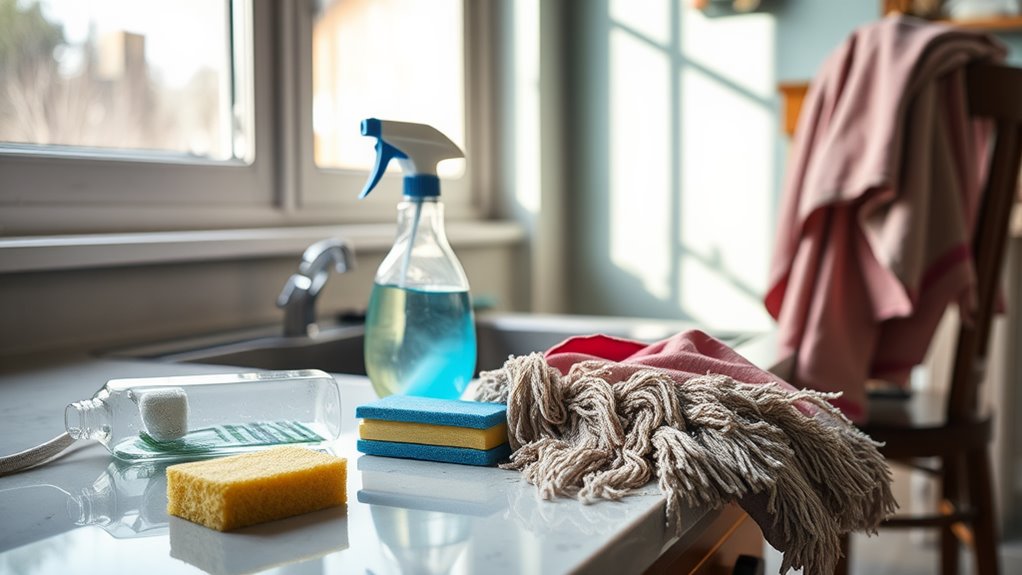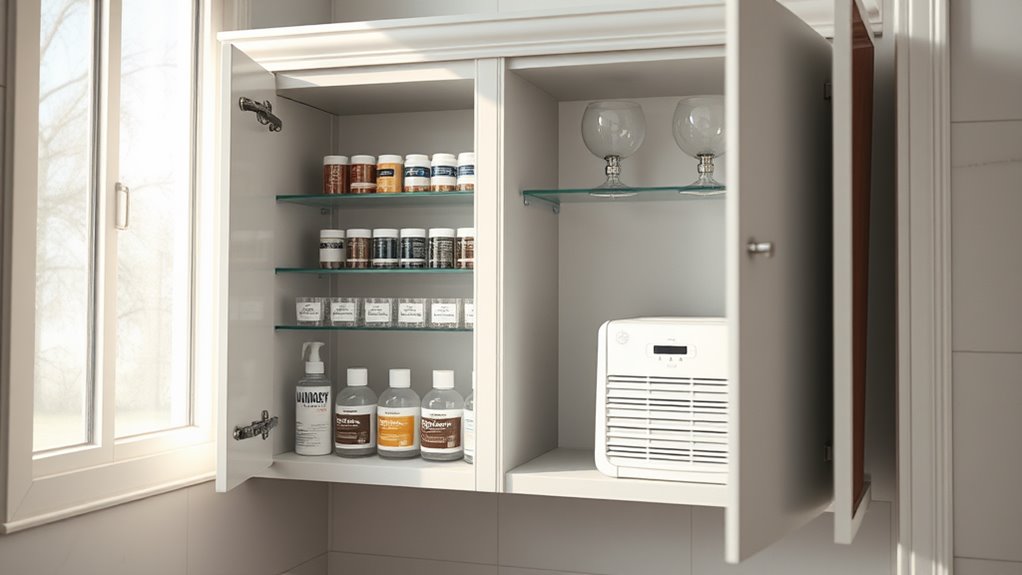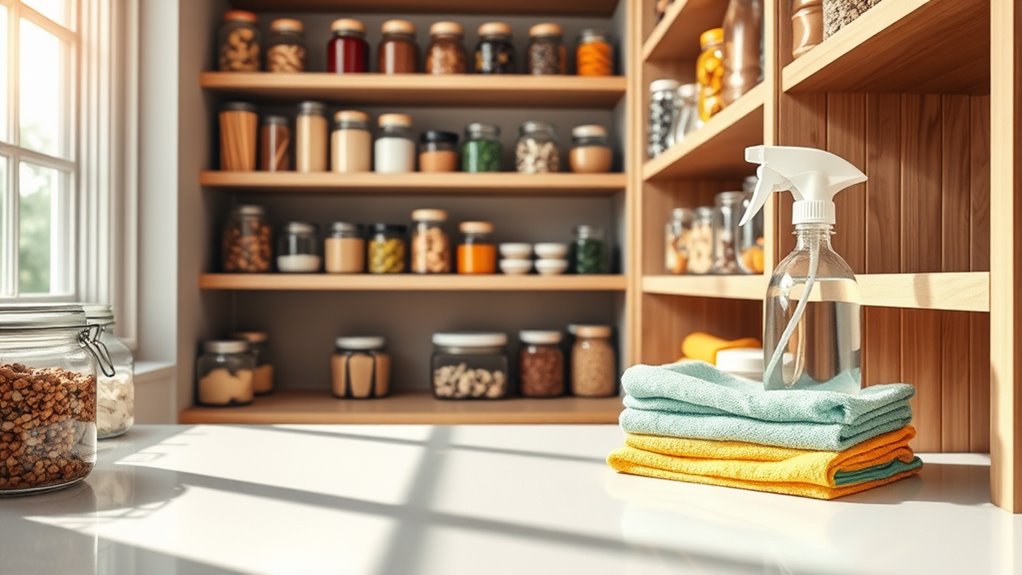6 Common Cleaning Mistakes You Didn’t Know You Were Making
You might be making critical cleaning mistakes that undermine your hard work. Overusing products can leave residues that attract dirt instead of removing it. Not checking labels may lead you to use wrong tools that damage surfaces. Skipping regular maintenance invites tougher cleaning jobs. Plus, ignoring high-touch surfaces can spread germs. Finally, rushing disinfectants prevents them from doing their job. Discovering these mistakes can make your cleaning effective, and there’s more to uncover about improving your routine.
Key Takeaways
- Overusing cleaning products can cause residue buildup, making surfaces dirtier instead of cleaner.
- Using improper surface cleaners can damage surfaces, such as glass cleaner on wood or bleach on fabrics.
- Skipping routine maintenance leads to tougher cleaning challenges and stubborn stains.
- Using the wrong cleaning tools can hinder effectiveness and cause damage to surfaces.
- Not allowing disinfectants adequate contact time can leave harmful germs behind.
Overusing Cleaning Products
Many people think that using more cleaning products means cleaner surfaces, but that’s a common misconception.
In reality, overusing cleaning products can lead to a buildup of residues that attract dirt rather than repel it. You might think you’re achieving a pristine finish, but you’re actually making a cleaning mistake.
Instead of relying on excessive amounts, focus on the right product for the job. A little goes a long way, and using too much can hinder effectiveness. Using excessive amounts can also lead to harmful chemical exposure and environmental damage. Additionally, many natural disinfectants provide effective cleaning solutions without the harsh chemicals found in conventional products, making them an ideal choice for eco-friendly cleaning alternatives. For instance, creating an eco-friendly all-purpose cleaner can help you maintain the shine on your kitchen appliances without the negative effects of harsh chemicals. Natural ingredients in your cleaner can enhance its effectiveness without causing harm. Moreover, using homemade cleaning solutions can be a cost-effective and environmentally friendly way to keep your bathroom sparkling clean.
Always work in manageable sections, allowing each product to do its job without being overwhelmed. By being mindful of your usage, you’ll achieve cleaner surfaces and save money in the process, transforming your cleaning routine into a more efficient practice.
Neglecting to Read Labels
When you skip reading product labels, you might miss vital instructions that guarantee safety and effectiveness.
Understanding chemical safety and proper usage can prevent accidents and enhance your cleaning routine.
Let’s explore why taking a moment to read labels can make all the difference.
Importance of Product Instructions
Neglecting to read product instructions can lead to ineffective cleaning and even damage to surfaces. Each cleaning product is designed with specific applications and methods for ideal results. By skipping this essential step, you risk using the wrong dilution, which can weaken the product’s efficacy or harm the surface you’re cleaning.
For instance, using a heavy-duty cleaner on delicate materials can cause discoloration or scratches. Additionally, improper application techniques, like using too much product or not allowing it to sit as directed, can undermine your efforts.
To achieve mastery in your cleaning routine, take the time to read labels carefully. Understanding the instructions guarantees you’re using the right product effectively, maximizing results while preserving your surfaces.
Understanding Chemical Safety
Understanding chemical safety is essential for effective cleaning and protecting your health. One major mistake you might be making is neglecting to read labels. Each cleaning product comes with vital information regarding its ingredients, potential hazards, and safety precautions.
If you skip this step, you could expose yourself to harmful chemicals or create dangerous reactions by mixing incompatible products. Pay attention to warning symbols and follow the guidelines for proper ventilation and protective gear.
Proper Usage Guidelines
Although you might think you know how to use cleaning products, overlooking proper usage guidelines can lead to ineffective cleaning or even accidents. By neglecting to read labels, you risk misusing products and compromising your safety.
Here are three essential points to remember:
- Dilution Instructions: Always follow the recommended dilution ratios. Using too much can damage surfaces or create harmful fumes.
- Application Method: Different products require specific application techniques. Spraying, wiping, or soaking can drastically change effectiveness.
- Safety Precautions: Labels often include critical safety information. Always wear gloves or masks if suggested to protect yourself from irritation or harmful chemicals.
Mastering these guidelines not only enhances your cleaning routine but also guarantees a safer environment for you and your family.
Using the Wrong Tools
When you clean, using the wrong tools can lead to frustration and ineffective results. Whether it’s improper surface cleaners, inadequate scrubbing tools, or the wrong cloth materials, these choices can hinder your efforts. Using the right tools not only enhances cleaning efficiency but also ensures proper maintenance techniques to extend the lifespan of your appliances. For homes with pets, using effective cleaning tools specifically designed to tackle pet hair and odors can make a world of difference in your cleaning routine. For instance, a rubber broom technique can be particularly effective for collecting pet hair from various surfaces. Additionally, selecting pet-safe cleaning products can help maintain a healthy environment for your furry friends. For instance, incorporating vinegar and baking soda into your cleaning arsenal can provide a natural and safe way to tackle tough stains. Let’s explore how the right tools can make a world of difference in your cleaning routine.
Improper Surface Cleaners
Using the right surface cleaner is essential for achieving effective results in your cleaning routine. Selecting the wrong cleaner can damage surfaces or leave them streaky.
Here are three common mistakes to avoid:
- Using Glass Cleaner on Wood****: It can strip the finish and damage the wood.
- All-Purpose Cleaners on Stone Surfaces: These can contain acids that etch and dull your countertops.
- Bleach on Fabrics: It can cause discoloration and irreparable damage to your textiles.
Understanding the specific needs of each surface will elevate your cleaning game.
Always read labels and choose cleaners designed for the surfaces you’re tackling.
Mastering this simple yet vital aspect will lead to a cleaner, more polished home overall.
Inadequate Scrubbing Tools
Choosing the right scrubbing tools can make a significant difference in your cleaning effectiveness. If you’re using a sponge for heavy-duty scrubbing, you’re likely wasting time and energy. Instead, opt for a stiff-bristle brush or a scrub pad designed for tough jobs.
Likewise, for delicate surfaces, a microfiber cloth is far more effective than a rough scrubber, preventing scratches while still lifting grime. Always match the tool to the task; using the wrong tool can lead to subpar results and potential damage.
Assess what you’re cleaning and select accordingly. Mastering this aspect of your cleaning routine not only improves results but also enhances your efficiency, allowing you to tackle more in less time.
Prioritize your tools for optimum performance.
Wrong Cloth Materials
Selecting the right cloth material can make or break your cleaning efforts. Using the wrong cloth can hinder your results and even damage surfaces. Here’s a quick guide to avoid common pitfalls:
- Microfiber: Ideal for dusting and polishing. Its fine fibers trap dirt without scratching surfaces.
- Cotton: Great for absorbing spills and general cleaning. However, it might leave lint behind on some surfaces.
- Sponge Cloths: Fantastic for scrubbing but can harbor bacteria if not properly sanitized.
Skipping Routine Maintenance
While it may seem tempting to skip routine maintenance, doing so can lead to bigger cleaning challenges down the line. Regular upkeep, like dusting, vacuuming, and checking appliances, prevents dirt and grime from accumulating. This proactive approach not only keeps your space looking pristine but also enhances its longevity. Implementing a strategic 15-minute daily cleaning routine can streamline your efforts and make maintenance feel effortless. Additionally, incorporating smart shortcuts can help maximize your cleaning efficiency during these brief sessions.
A consistent cleaning schedule can help you maintain high-impact tasks that keep your home tidy and inviting. By adhering to a planned balanced weekly schedule, you can tackle cleaning tasks systematically and avoid overwhelming build-up. When you neglect routine tasks, you invite stubborn stains and damage, making future cleaning exponentially harder. By dedicating just a small amount of time each week to maintenance, you’re saving yourself hours of intense scrubbing later. Incorporating a weekly deep cleaning routine can also significantly reduce the effort needed for regular upkeep.
Develop a system that works for you—set reminders or create a checklist. Mastering routine maintenance is a key step in achieving a truly clean and inviting environment, ensuring your efforts pay off in the long run.
Ignoring High-Touch Surfaces
Neglecting high-touch surfaces can lead to a buildup of germs and grime that compromises your home’s cleanliness.
These surfaces often go unnoticed, yet they play a vital role in your health.
Here are three high-touch areas you should prioritize:
- Doorknobs and Handles – These are frequently used, making them hotbeds for bacteria.
- Light Switches – You may not think about them, but they’re touched multiple times a day.
- Remote Controls and Devices – With everyone reaching for them, they need regular attention.
Not Allowing Time for Disinfectants to Work
Even though you might be enthusiastic to wipe surfaces clean, not allowing enough time for disinfectants to work can undermine your efforts. Disinfectants need contact time to effectively kill germs, and rushing this process can leave harmful pathogens behind. Follow the guidelines below to maximize your cleaning routine:
| Disinfectant Type | Recommended Contact Time | Common Mistakes |
|---|---|---|
| Spray | 5-10 minutes | Wiping too soon |
| Wipes | 4 minutes | Not using enough wipes |
| Liquid solutions | 10 minutes | Diluting too much |
| UV Light | 30 seconds per area | Inconsistent application |
| Steam Cleaner | 10 seconds per inch | Moving too fast |
Frequently Asked Questions
Can Natural Cleaners Be as Effective as Commercial Products?
Yes, natural cleaners can be just as effective as commercial products when used correctly. You can harness their power by understanding their properties and applying them strategically to tackle specific stains and surfaces in your home.
How Often Should I Clean Specific Areas in My Home?
You should clean high-traffic areas weekly, kitchens and bathrooms bi-weekly, and less frequented spaces monthly. Regular upkeep prevents buildup and keeps your home fresh, making it easier to maintain a clean and organized environment.
Are There Eco-Friendly Cleaning Alternatives Available?
Yes, there are plenty of eco-friendly cleaning alternatives available. You can use vinegar, baking soda, or essential oils to tackle dirt and grime effectively, ensuring your home stays clean without harmful chemicals impacting the environment.
What Are the Best Practices for Cleaning Electronic Devices?
To clean electronic devices, unplug them first. Use a microfiber cloth for screens, and a soft brush for keyboards. Avoid harsh chemicals, and make certain moisture doesn’t enter openings. Regular maintenance keeps your devices in top shape.
How Can I Safely Dispose of Unused Cleaning Products?
To safely dispose of unused cleaning products, check local regulations, use designated hazardous waste facilities, and avoid pouring them down drains. Always keep them in their original containers and clearly label them for safety.



